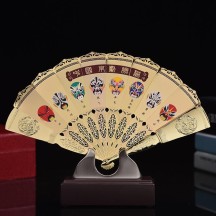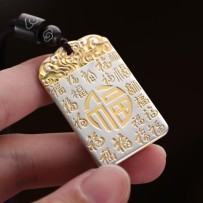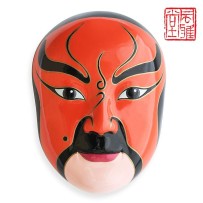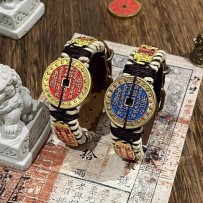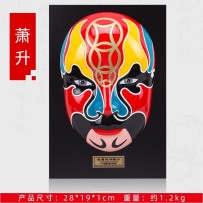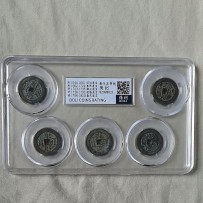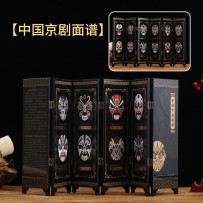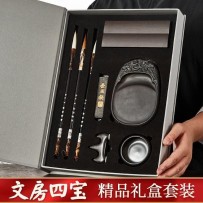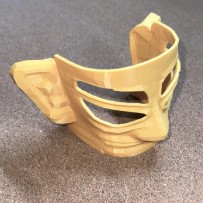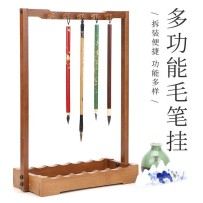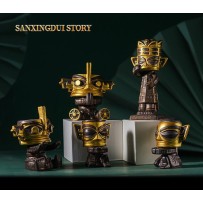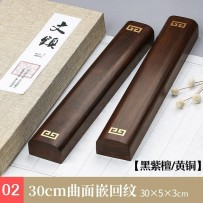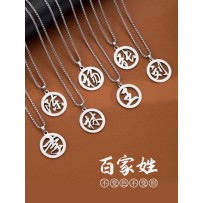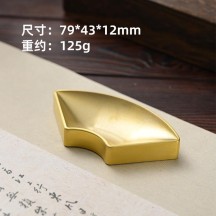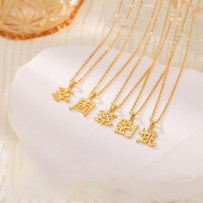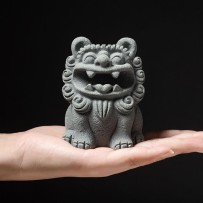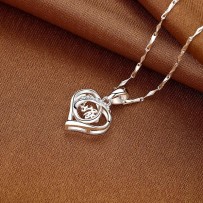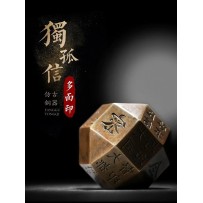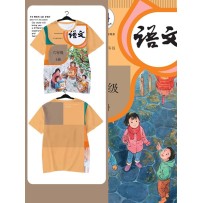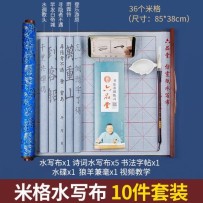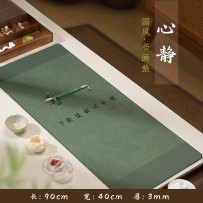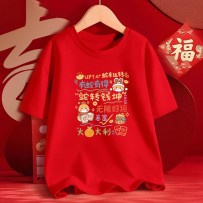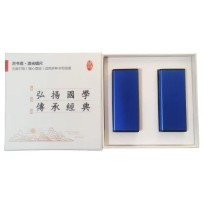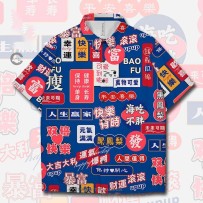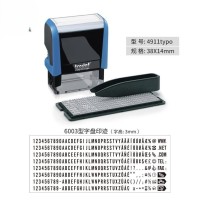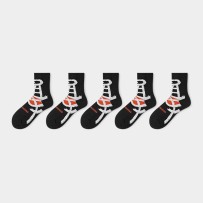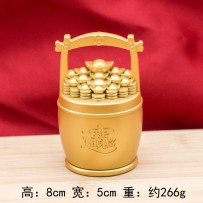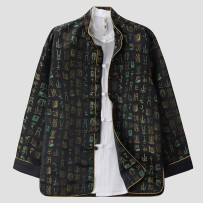Chinese fan culture carries a profound cultural heritage and is an integral part of the nation's traditions. Beyond being used for cooling, fans also serve as props in dance and stage performances, symbolizing friendship and connection. They make thoughtful gifts for friends, family, and international guests. Today, fan decorations are increasingly found in homes and have gradually evolved into objects of artistic appreciation, greatly enhancing their cultural and aesthetic value.
Subcategories
Active filters
The Peaceful and Trouble-free plaque is a type of jade pendant. Because the entire jade plaque is not carved, there is a saying in the jade industry that things without any carvings are called "nothing", so the jade plaque borrows the meaning of "peaceful and trouble-free". "Peaceful and Trouble-free" means peace and everything goes well.
Facial makeup in Peking Opera is a decorative art form that combines dots, lines, shapes, and colors in an organic way. With vibrant hues, elegant designs, and exaggerated stylization, it vividly and expressively portrays the appearance and personality traits of theatrical characters. This art form reflects the aesthetic creativity and cultural spirit of the Chinese people.
The talisman money is a Taoist prayer object. These coins are cast with patterns of the Eight Diagrams, immortals, Taishang Laojun, and the God of Thunder. The mountain ghost flower money is a carrier used by Taoist priests in the Qing Dynasty to cast spells to subdue demons and exorcise ghosts. It can also be called a magic tool. After being consecrated by Taoist priests, people are requested to hang it in their homes or carry it with them to ensure safety.
Facial makeup in Peking Opera is a decorative art form that combines dots, lines, shapes, and colors in an organic way. With vibrant hues, elegant designs, and exaggerated stylization, it vividly and expressively portrays the appearance and personality traits of theatrical characters. This art form reflects the aesthetic creativity and cultural spirit of the Chinese people.
The Five Emperors' Coins refer to five round copper coins with square holes, which symbolize the power of the five elements and the five directions, and have the function of warding off evil spirits and bringing good fortune. The saying that the five emperors minted coins is mostly fabricated by later generations. People call the coins issued by several dynasties the Great Five Emperors' Coins. The Great Five Emperors' Coins are made of bronze, including the Qin Banliang, the Han Wuzhu, the Tang Kaiyuan Tongbao, the Song Yuan Tongbao, and the Ming Yongle Tongbao.
Facial makeup in Peking Opera is a decorative art form that combines dots, lines, shapes, and colors in an organic way. With vibrant hues, elegant designs, and exaggerated stylization, it vividly and expressively portrays the appearance and personality traits of theatrical characters. This art form reflects the aesthetic creativity and cultural spirit of the Chinese people.
The early forms of ancient coins were mainly shellfish. In China, from the late primitive society to the Xia, Shang and Zhou dynasties, the main form of currency was physical currency, and the most widely circulated was natural shellfish. Later, a small amount of metal weighing currency and coins appeared.
The Four Treasures of the Study—paper, brush, ink, and inkstone—are traditional Chinese tools for writing and painting. They have made remarkable contributions to the promotion of Chinese culture and the advancement of global civilization. Even today, they continue to play an important role.
Sanxingdui culture can be traced back to the Xia and Shang dynasties, about 3,000 to 5,000 years ago.
The unearthed masks, especially the "bulging-eyed bronze statue" (also known as the "bronze man mask") with abnormally protruding eyeballs, show the uniqueness and mystery of the ancient Shu civilization
Based on the appearance of the Sanxingdui bronze man mask, this 3D printed model basically reproduces the details and unique shape of the original mask.
It cannot be guaranteed to be completely consistent with the unearthed original, so it is only used as a display of space ornaments such as office desks, entertainment and leisure, and national style displays.
A brush hanger is a tool used to suspend brushes from a rack, while a brush rest—also known as a "brush mountain" or "brush holder"—is primarily used to rest brushes when not in use. These rests come in a variety of materials and are often shaped like mountains.
Sanxingdui civilization is so brilliant and unique that its interpretation cannot be limited to the material culture level. Sanxingdui's vast ancient city, splendid bronze products, magnificent art and the grand ritual regulations it carries contain the key for future generations to "decode"; gold products, jade, seashells, and ivory are all material manifestations of the ancient Shu civilization system and spirit. Through the analysis of the unearthed cultural relics in Sanxingdui, we can deeply reveal the institutional and civilization characteristics of the ancient Shu Kingdom in Sanxingdui.
A paperweight is a tool used to hold down books, documents, letters, and other items to prevent them from being blown away by the wind. It serves both practical and decorative purposes and can also be appreciated as a collectible item. Reflecting the owner's interests and taste, it adds a unique touch to any writing desk.
The original source of ancient Chinese surnames is the primitive religious worship, totem worship and ancestor worship based on "the way of heaven". Primitive totem worship is the root of ancient Chinese surnames. A large number of ancient documents support this view. Chinese surnames first had surnames and then clan names. The emergence of surnames is a sign that primitive humans gradually got rid of the state of ignorance. Surnames and clan names are two stages of human civilization progress.
The "bi tian" (brush licker) is one of the traditional scholar’s tools in ancient China, also known as a brush inkstone. Its main function is to test the ink concentration on the brush tip or to smooth the brush bristles, making it more convenient for calligraphy and painting.
The original source of ancient Chinese surnames is the primitive religious worship, totem worship and ancestor worship based on "the way of heaven". Primitive totem worship is the root of ancient Chinese surnames. A large number of ancient documents support this view. Chinese surnames first had surnames and then clan names. The emergence of surnames is a sign that primitive humans gradually got rid of the state of ignorance. Surnames and clan names are two stages of human civilization progress.
A paperweight is a tool used to hold down books, documents, letters, and other items to prevent them from being blown away by the wind. It serves both practical and decorative purposes and can also be appreciated as a collectible item. Reflecting the owner's interests and taste, it adds a unique touch to any writing desk.
Design inspiration: I have you in my heart and I will never leave you. Two hearts intertwined, moving into each other's new house
A paperweight is a tool used to hold down books, documents, letters, and other items to prevent them from being blown away by the wind. It serves both practical and decorative purposes and can also be appreciated as a collectible item. Reflecting the owner's interests and taste, it adds a unique touch to any writing desk.
This dress is made of ice silk quick-drying fabric, which is cool and comfortable to wear
Calligraphy copybooks play an irreplaceable role in the study of calligraphy. They are not only an effective way to improve calligraphy skills, but also an important tool for cultivating aesthetic appreciation, developing patience and concentration, and preserving the cultural heritage of calligraphy.
Personalized text short-sleeved fun culture shirt
The felt mat for calligraphy and painting helps enhance the expression of the art. Writing on a table covered with felt feels very comfortable for the hand. The elasticity of the felt mat makes it easier to control the brush tip, which helps improve brush technique and develop a better tactile feel.
The duty of a paperweight (zhenchi) is not merely to hold down paper — it also serves as a symbolic warning, signaling that outsiders should not casually touch the owner's personal belongings. Beyond its practical use, the zhenchi embodies meanings such as "calming the mind" and "protecting the home," helping one remain composed and ward off negative energies. The "ruler" (chi) aspect of its name also represents a tool of measurement, symbolizing that a gentleman conducts himself with rules and boundaries. As an essential item on a scholar’s desk, the paperweight is not just a functional object, but also a refined work of art that brings aesthetic pleasure.
New Year Good Luck Oversized Short Sleeve Shirt
The Advantages and Functions of Movable Type Stamps Include:
-
Reusable:
Movable type stamps can be disassembled and rearranged, allowing for adjustments to different printing content. This makes them reusable. -
Improved Printing Efficiency:
Compared to woodblock printing, movable type allows for faster typesetting and printing, significantly enhancing efficiency. -
Reduced Storage Space:
After printing, the individual type blocks can be disassembled and stored, requiring much less space than traditional woodblock printing. -
Adaptable to Various Needs:
Movable type stamps can accommodate a wide range of characters and patterns, including rare or uncommon characters, and can be assembled on demand.
Cotton socks trendy national style sports deodorant breathable autumn and winter mid-tube socks
A wealth figurine generally symbolizes prosperity and good fortune, with the hope of attracting wealth and success in one’s career. These figurines are typically used as decorative items, placed in homes or shops with the intention of bringing financial luck and positive energy.
Oracle gold-stamped jacquard hand-buttoned jacket











